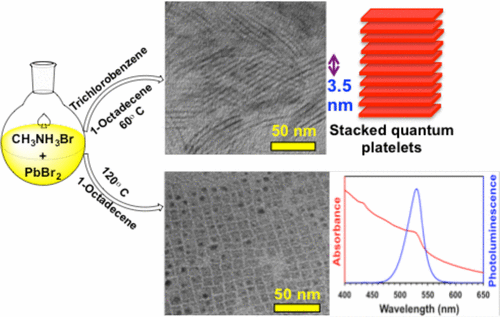当前位置:
X-MOL 学术
›
Chem. Mater.
›
论文详情
Our official English website, www.x-mol.net, welcomes your
feedback! (Note: you will need to create a separate account there.)
Programmable Colloidal Approach to Hierarchical Structures of Methylammonium Lead Bromide Perovskite Nanocrystals with Bright Photoluminescent Properties
Chemistry of Materials ( IF 7.2 ) Pub Date : 2017-04-17 00:00:00 , DOI: 10.1021/acs.chemmater.6b05393 Meghan B. Teunis 1 , Merrell A. Johnson 2 , Barry B. Muhoberac 1 , Soenke Seifert 3 , Rajesh Sardar 1, 4
Chemistry of Materials ( IF 7.2 ) Pub Date : 2017-04-17 00:00:00 , DOI: 10.1021/acs.chemmater.6b05393 Meghan B. Teunis 1 , Merrell A. Johnson 2 , Barry B. Muhoberac 1 , Soenke Seifert 3 , Rajesh Sardar 1, 4
Affiliation

|
Systematic tailoring of nanocrystal architecture could provide unprecedented control over their electronic, photophysical, and charge transport properties for a variety of applications. However, at present, manipulation of the shape of perovskite nanocrystals is done mostly by trial-and-error-based experimental approaches. Here, we report systematic colloidal synthetic strategies to prepare methylammonium lead bromide quantum platelets and quantum cubes. In order to control the nucleation and growth processes of these nanocrystals, we appropriately manipulate the solvent system, surface ligand chemistry, and reaction temperature causing syntheses into anisotropic shapes. We demonstrate that both the presence of chlorinated solvent and a long chain aliphatic amine in the reaction mixture are crucial for the formation of ultrathin quantum platelets (∼2.5 nm in thickness), which is driven by mesoscale-assisted growth of spherical seed nanocrystals (∼1.6 nm in diameter) through attachment of monomers onto selective crystal facets. A combined surface and structural characterization, along with small-angle X-ray scattering analysis, confirm that the long hydrocarbon of the aliphatic amine is responsible for the well ordered hierarchical stacking of the quantum platelets of 3.5 nm separation. In contrast, the formation of ∼12 nm edge-length quantum cubes is a kinetically driven process in which a high flux of monomers is achieved by supplying thermal energy. The photoluminescence quantum yield of our quantum platelets (∼52%) is nearly 2-fold higher than quantum cubes. Moreover, the quantum platelets display a lower nonradiative rate constant than that found with quantum cubes, which suggests less surface trap states. Together, our research has the potential both to improve the design of synthetic methods for programmable control of shape and assembly and to provide insight into optoelectronic properties of these materials for solid-state device fabrication, e.g., light-emitting diodes, solar cells, and lasing materials.
中文翻译:

具有明亮光致发光特性的甲基铵溴化铅钙钛矿纳米晶体的层级结构的可编程胶体方法
纳米晶体体系结构的系统定制可以为各种应用提供对其电子,光物理和电荷传输特性的空前控制。然而,目前,钙钛矿纳米晶体形状的控制主要是通过基于试验和错误的实验方法来完成的。在这里,我们报告系统的胶体合成策略,以准备甲基铵溴化铅量子血小板和量子立方体。为了控制这些纳米晶体的成核和生长过程,我们适当地控制了溶剂系统,表面配体化学性质和反应温度,使合成过程变成各向异性的形状。我们证明了反应混合物中氯化溶剂和长链脂族胺的存在对于形成超薄量子片(厚度约2.5 nm)至关重要,这是由中尺度辅助球形种子纳米晶体的生长(〜通过将单体连接到选择性晶体面上来实现直径1.6 nm)。结合了表面和结构特征以及小角度X射线散射分析,证实了脂肪族胺的长碳氢化合物负责3.5 nm分离的量子血小板的有序分层堆积。相反,〜12 nm边长的量子立方的形成是一个动力学驱动的过程,其中通过提供热能实现了高单体通量。我们的量子血小板的光致发光量子产率(〜52%)比量子立方体高近2倍。此外,量子血小板显示出的非辐射速率常数比量子立方体低,这表明较少的表面陷阱态。总之,我们的研究有潜力改善用于形状和装配的可编程控制的合成方法的设计,并提供对这些材料用于固态器件制造的光电性能的见解,例如发光二极管,太阳能电池和激光材料。
更新日期:2017-04-17
中文翻译:

具有明亮光致发光特性的甲基铵溴化铅钙钛矿纳米晶体的层级结构的可编程胶体方法
纳米晶体体系结构的系统定制可以为各种应用提供对其电子,光物理和电荷传输特性的空前控制。然而,目前,钙钛矿纳米晶体形状的控制主要是通过基于试验和错误的实验方法来完成的。在这里,我们报告系统的胶体合成策略,以准备甲基铵溴化铅量子血小板和量子立方体。为了控制这些纳米晶体的成核和生长过程,我们适当地控制了溶剂系统,表面配体化学性质和反应温度,使合成过程变成各向异性的形状。我们证明了反应混合物中氯化溶剂和长链脂族胺的存在对于形成超薄量子片(厚度约2.5 nm)至关重要,这是由中尺度辅助球形种子纳米晶体的生长(〜通过将单体连接到选择性晶体面上来实现直径1.6 nm)。结合了表面和结构特征以及小角度X射线散射分析,证实了脂肪族胺的长碳氢化合物负责3.5 nm分离的量子血小板的有序分层堆积。相反,〜12 nm边长的量子立方的形成是一个动力学驱动的过程,其中通过提供热能实现了高单体通量。我们的量子血小板的光致发光量子产率(〜52%)比量子立方体高近2倍。此外,量子血小板显示出的非辐射速率常数比量子立方体低,这表明较少的表面陷阱态。总之,我们的研究有潜力改善用于形状和装配的可编程控制的合成方法的设计,并提供对这些材料用于固态器件制造的光电性能的见解,例如发光二极管,太阳能电池和激光材料。































 京公网安备 11010802027423号
京公网安备 11010802027423号